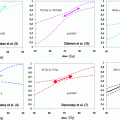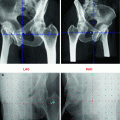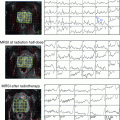First author
Study design
Key findings
Eligible patients (pts) had A2 (occult disease >3 + chips & poorly differentiated) and Stage B without clinical (imaging) or biopsy + LNI, randomized to PORT or WPRT to 45 Gy then a boost to 65 Gy
At a median fu has been 7 yrs, (n = 445), no benefit with WPRT. Path node (-) had a better outcome
Phase Randomized Trial III testing whether WPRT improves progression-free survival (PFS), with either neoadjuvant (NHT) or adjuvant (AHT) HT
WPRT improves PFS. Larger fields associated with better outcome with NHT
Pommier et al. (2007)
444 pts with T1b-T3N0M0 randomized to 66-70 Gy to prostate ± 46 Gy (top border S1/S2). 4–8 mo NHT allowed for “high-risk” pts. ~55 % of pts had LN risk <15 % (Roach equation)
WPRT did not improve OS or PFS but none of the pts received WPRT defined as superior border at L5 S1
Pollack RTOG 0534
Salvage RT & High-risk PORT versus WPRT
Ongoing
Roach RTOG 0924
Trial target 2580 int. & High-risk PORT versus WPRT
Ongoing
Table 2
Definitive retrospective series evaluating WPRT versus PORT
First author | Study design | Key findings |
|---|---|---|
Seaward et al. (1998b) | Retrospective analysis of patients undergoing prostate only or WPRT with and without HT | WPRT improves PFS |
Pan et al. (2002) | Retrospective analysis 3D-CRT (n = 1832), 3 categories of LNI: low, 0–5 %; int., >5–15 %; and high, >15 % (Partin Tables) | Benefit for int-risk pts with WPRT 2-year PSA control, 90 % versus 81 % (p = 0.02) |
Jacob et al. (2005) | Retrospective, pts with risk +LN >15 % pelvic RT versus, partial pelvic, or prostate only (n = 420). Concluded RT dose the major determinant of PSA control | No benefit to WPRT. Criticism none of the pts received WPRT as defined by RTOG 9413 |
Aizer et al. (2009) | Retrospective, 277 pts with >15 % risk of LNI treated with prostate only (75.5 %) or WPRT (24.5 %) | WPRT improved 4 yr control (69.4 % versus 86.3 %) |
Milecki et al. (2009) | Retrospective analysis including men with High-Risk Disease (n = 162) with and without WPRT | 5-yr CSS were 90 % versus 79 % (p = 0.01) & PSA control 52 % versus 40 % (p = 0.07) |
Table 3
Post Op and/or pathologic node positive series evaluating WPRT versus PORT
First author | Study design | Key findings |
|---|---|---|
Spiotto et al. (2007) | 160 patients underwent adjuvant or salvage RT after RP. WPRT resulted in PSA control in high-risk patients at 5-years 47 % versus. 21 % (p = 0.008) | Better PSA control for high-risk pts receiving WPRT after RP |
Retrospective, 250 pts with LNI. 129 pts (51.6 %) with WPRT & HT & 121 pts (48.4 %) HT alone | RT improved PSA control & CSS (p = 0.002 & 0.009) | |
Matched comparison 117 pts AHT + RT with 247 pts with RT alone | RT improved CSS & OS (p = 0.004 & < 0.0012) | |
Moghanaki et al. (2013) | Study compared outcomes for pts who received SRT with WPRT (n = 112) versus (PORT) (n = 135). 247 pts were analyzed with a median fu of 4 yrs | Pts with PSA ≥ 0.4 ng/mL, WPRT improve PSA control (P = 0.03) |
Johnstone et al. (2007) | Surveillance Epidemiology End Results (SEER) registry used to evaluate the efficacy of post-op RT in 1921 node + pts who underwent RP alone, or RP & RT | No significant survival benefit for +LN pts receiving post-op RT |
Tward (2013) | Retrospective analysis using SEER data including men with High-Risk Disease (cT1-T4, cN1) with and without WPRT | 5-yr CSS: 90 versus 79 % (p = 0.01) & PSA control 52 versus 40 % (p = 0.07), respectively |
3.1 Randomized Trials Evaluating Prophylactic Radiotherapy
Table 1 summarizes the major phase III randomized trials addressing WPRT either completed or in progress. Radiation Therapy Oncology Group (RTOG) 7706 was the first prospective trial comparing prostatic versus pelvic irradiation and it failed to demonstrate a benefit to WPRT (Asbell et al. 1988; Hanks et al. 1994). However, this study was conducted in the pre-PSA era was relatively small and was largely composed of patients with low risk disease. Low risk patients (some of whom were surgically staged and proven to be node negative), are the patients least likely to benefit from WPRT, thus this study does not address the role of WPRT in higher risk patients.
GETUG-01 was a small-randomized trial conducted in France (n = 444) including patients clinically staged as T1b-T3, N0 and randomized to WPRT or PORT. The authors concluded that 5-year PFS and overall survival were similar in the two arms with 42 months follow up (Pommier et al. 2007). However, patients in the WPRT arm had the superior limit of the pelvic fields placed at the level of S1/S2, and 55 % of patients in this study had pelvic lymph node risk for metastasis <15 % (Roach equation). In addition, not all patients received HT (critical to the findings of RTOG 9413, discussed below). Furthermore, the ASTRO definition was used to assess biochemical failure, which lacks sensitivity and specificity for clinical failure and death in patients treated with HT compared with Phoenix definition (Roach et al. 2006b). Therefore, the results of GETUG-01 should not be considered definitive proof against WPRT due to the small size of the study, small field sizes used for pelvic EBRT and patient selection.
The RTOG conducted the largest phase III Trial testing the value of WPRT completed to date (Roach et al. 2003). RTOG 9413 included a total of 1,323 patients with intermediate to high-risk PC with risk of LN involvement ≥15 % (Roach’s equation). This study compared WPRT versus PORT as well as adjuvant HT (AHT) versus neoadjuvant plus concurrent HT (NHT) with progression-free survival (PFS) as the primary end point. This study demonstrated that there was an improvement in PFS with NHT + WPRT.
The importance of field size on outcome was highlighted in a post hoc analysis looking at field size among patients treated on the NHT arms (chosen to avoid the timing bias favor AHT). In this analysis we compared Arm 1 (NHT + WPRT) (defined as having a superior border placed at the L5 S1 junction, being ~17 cm in length) versus Arm 2 divided into two subgroups based on the median field size used among patients randomized to this arm. The larger of the PORT subgroups was called “mini-pelvis” (MP) and was corresponded approximately to the bottom of the sacroiliac joints (maximum field size ≤11 × 11 cm but >10 × 11 cm) and compared to the subgroup treated with the smaller field, called “prostate only” with a maximum field size being <10 × 11. This analysis showed that the 7-year DFS was 40, 35, and 27 % for patients treated to WPRT, MP and “prostate only”, respectively (p = 0.02) (Roach et al. 2006a). Thus, there appears to be a clear relationship between PFS and field size in patients with intermediate to high-risk disease. On this basis RTOG 0924 was designed to use even larger fields than 9413. An intermediate update of RTOG 9413 continued to show an improvement in PSA control with NHT + WPRT compared to NHT + PORT but perhaps due to the timing bias (favoring the adjuvant arms), and death from other causes (included in the PFS definition), PFS survival differences were reduced (Lawton et al. 2007).
3.2 Retrospective Studies of Definitive Prophylactic WPRT
Most retrospective studies support the role of WPRT as shown in Table 2. Investigators from UCSF reported better PSA control rates when WPRT was administered with NHT particularly when patients had the risk of LNI between 15 and 35 % (Seaward et al. 1998a, b). Investigators from University of Michigan divided their patients into 3 categories of LNI: low, 0–5 %; intermediate, >5–15 %; and high, >15 % (Partin) and in the multivariate analysis concluded that there was a statistically significant benefit with WPRT (Pan et al. 2002). In a retrospective study from Yale, Aizer et al. reported on 277 patients with at least a 15 % likelihood of LNI, that the 4-year PSA control rate was 69.4 % in the PORT and 86.3 % in the WPRT group (Aizer et al. 2009). In contrast, investigators from Fox Chase concluded there was no benefit to the addition of WPRT in patients with a risk of LNI >15 % (Roach Equation) (Jacob et al. 2005). However, none of the patients included in their study were treated with WPRT as defined on RTOG 9413, most were treated with a MP field, and very few received NHT and most were much more favorable than those treated on RTOG 9413. Milecki et al. retrospectively studied 162 high-risk patients and concluded that WPRT combined with NHT improved cause specific survival (CSS) and PSA control compared to PORT and HT.
Stay updated, free articles. Join our Telegram channel

Full access? Get Clinical Tree






